Electric Current - 5
d) Potentiometer :-
It is a device used to measure potential difference with high accuracy, without drawing any current from the unknown source. [* Basic Figure of a potentiometer : ??]
Principle of Potentiometer
It is based on the principle, that a current carrying wire has potential difference across its ends proportional to its length with a uniform cross sectional area.
It can be used for various purpose :
(1) To find e.m.f. of an unknown battery :
First a known battery (Ek) is placed as :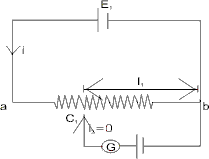

Suppose the null point is at l1
Then, Ek = i(l l1) ………………………………………(1)
Dumb Questions - 15. What is this null point ?
Ans :- On a close observation we can see that potentiometer is similar to wheatston’s bridge.
At null point current through galvanometer equals 0.
Now, the known battery is replaced by unknown battery (Eu).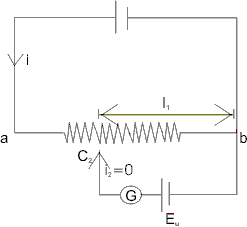
Now, Eu = I(l l2) ………………………………………. (2)
From (1) and (2)
2. Find internal resistance(r) of an unknown battery. , where R is a known resistance.
, where R is a known resistance.
For any circuit for battery : V = E -ir = iR ………………………………….. (A)
………………………………….. (A)
Where R = external resistance.
r = internal resistance.
We connect a battery of e.m.f. E and internal resistance r as: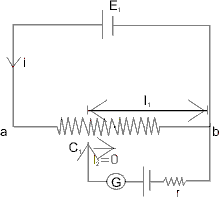
Now, E = ill1 …………………………………………. (1) Now a known resistance R is connect across the terminals as :
Now, 
 ……………………………………… (2)
……………………………………… (2) from (1) and (2)
from (1) and (2) ……………………………………… (3)
……………………………………… (3)
Now, placing value of (3) in (A) :
Question :- Find current in all branches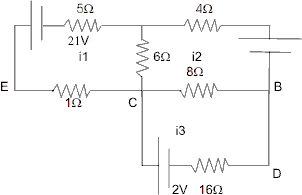
Ans :- Assume the current distribution as shown :
Applying kirchoff’s loop law in the three loops we get :
2l - Si1 - 6(i1 + i2) - i1 = 0 ………………………………….. (1)
S - 4i2 - 6(i1 + i2) - 8(i1 + i3) = 0 …………………………..(2)
2 - P(i2 + i3) - 16i3 = 0 ……………………………………… (3)
On simultaneously solving there three equations we get :
Dumb Question - 16. In branch AC which will we Lonsides i1, i2 ?
Ans :- We will Lonsides the current i1 + i2 in AC as we have Lonsidered that in those two loops different currents i1 and i2 are flowing now, their common edge will have the sum according to the direction of two currents. This is called principle of superposition.
E2 :- Two resistance have temprature coefficient  1 and
1 and  2 and R01 an R02 the resistance at 00C. Find
2 and R01 an R02 the resistance at 00C. Find  eq if they both are connect (a) in series and (b) in parallel ?
eq if they both are connect (a) in series and (b) in parallel ?
Ans :- For series :
At 00C Req = R01 + R02 ………………………………………… (1)
At any temperature t0C
Req = R01 + R02 Req = R01[1 +
Req = R01[1 +  1(t - 0)] + R02[1 +
1(t - 0)] + R02[1 +  2(t - 0)]
2(t - 0)] [R01 + R02][1 +
[R01 + R02][1 +  eqt] = R01[1 +
eqt] = R01[1 +  1t] + R02[1 +
1t] + R02[1 +  2t]
2t]
In Parallel :
At t0C 
Using Binomial Expansion :
E3. A rod length L and cross sectional area A lies along the axis between x = 0 and x = L.
Its resistivity is given by : P(x) = P0 .
.
The end x = 0 is at a potential V0 and x = L at V = 0.
(a) Find net resis tance of the rod.
(b) The electric potential V (n) ?
Ans :- (a)
At any distance n suppose an elementary particle dn be considered such that dn  0.
0.
Its resistance 
As R = 

Thus, R = 

(b) We know that,
Potential difference = i dR = dV
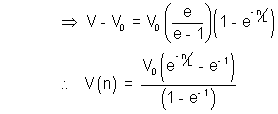
04. A battery of e.m.f. 1.4V and internal resistance 2 is connected to a 100
is connected to a 100 resistor through an ammeter. The resistance of te ammeter is
resistor through an ammeter. The resistance of te ammeter is  .
.
If ammeter rods .02 A. What is the resistance of the Voltmeter ?
Ans :- Circuit diagram is :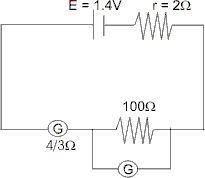
Now first finding total resistance of the circuit.
where G = Resistance of voltmeter.
Now, Current = 


In the given circuit 5 resistor develops 45 J/s Power due to current flowing through it. Calculate the heat developed/second through 2
resistor develops 45 J/s Power due to current flowing through it. Calculate the heat developed/second through 2 resistor ?
resistor ?
Ans :- Assume the shown current distribution after writing equivalent circuit :